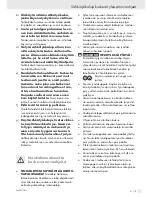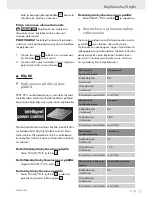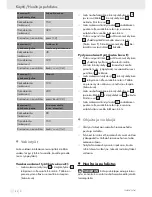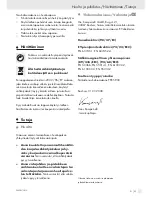
11
GB/IE/CY
j
The auxiliary handle
7
can be adjusted or
removed to allow you to sand difficult-to-
reach places.
Q
Vacuum dust extraction
WarNING!
DaNGEr OF FIrE!
There is
the danger of fire when working with electrical de-
vices that have a dustbox or can be connected to a
vacuum cleaner. Under certain conditions the
wood dust in the dust collection box (or in the vacu-
um‘s dust bag) may self-ignite, e.g. as a result of
flying sparks generated when abrading metals or
metal objects left in wood. This can happen partic-
ularly if the wood dust is mixed with paint residue
or other chemicals and the abraded particles are
hot from prolonged abrasion. Therefore you must
empty the device’s dust collection box and the vac-
uum cleaner’s dust bag before taking a break or
stopping work and always avoid overheating of the
abraded particles and the device.
Wear a dust mask!
Dust extraction using the dust collection
box:
j
Slide the dust collection box
10
on to the dust
extraction spout
5
on the side of the device
(Fig. C).
Emptying the dust collection box:
j
Pull the dust collection box
10
off the dust ex-
traction spout
5
. Press the 2 unlocking buttons
(one on each side) and open the dust collection
box
10
, knock out the contents on a solid surface.
Dust extraction using external vacuum
extraction:
WarNING!
If there is an explosive mixture
of dust and air you must use a vacuum device espe-
cially intended for that purpose.
DaNGEr OF FIrE!
Do not use vacuum dust
extraction (dust collection box or vacuum cleaner)
when sanding metals (flying sparks).
1. Push the extraction adapter
11
on to the dust
extraction spout
5
on the side of the device
(see Fig. C).
2. Slide the hose of a suitable dust extraction de-
vice approved for that purpose (e.g. a workshop
vacuum cleaner) on to the extraction adapter
11
.
Q
Operation
Q
Switching on and off
The PEBS 900 belt sander has full-wave electronics
with additional control electronics, soft start with
inrush current limiting.
When operating the belt sander you can select
between intermittent or continuous operation mode.
For short sanding tasks use the intermittent operation
mode. For longer sanding tasks we recommend the
continuous operation mode. Whilst working in your
selected mode the device functions as follows:
To switch on intermittent operation
mode:
j
Press the ON / OFF switch
3
.
To switch off intermittent operation
mode:
j
Release the ON / OFF switch
3
.
To switch on continuous operation
mode:
j
Press the ON / OFF switch
3
, and keep it
pressed, then press the locking knob
2
.
To switch off continuous operation
mode:
j
Press and then release the ON / OFF switch
3
.
Preparing for use / Operation
Summary of Contents for PEBS 900 SE
Page 2: ...A 6 B 10 11 C D E F 6 5 7 8 1 2 3 4 12 13 14 14 16 15 9...
Page 22: ...24...
Page 32: ...34...
Page 52: ...54...
Page 53: ...55 GR CY E 56 56 57 57 57 58 58 58 59 60 60 61 61 62 62 63 64 64 64 64 65...
Page 54: ...56 GR CY PEBS 900 Q E Q Q 1 2 3 4 5 6 7 8 9 10 11 II n0 V Volt W Watt...
Page 56: ...58 GR CY 1 2 3...
Page 57: ...59 GR CY 4...
Page 58: ...60 GR CY J J J J J J J J J J J J J D J J Q 230V 220V Q 1 9 A...
Page 59: ...61 GR CY 2 3 9 j 6 6 Q j j j 7 Q j 10 5 C j 10 5 10...
Page 60: ...62 GR CY 1 11 5 C 2 11 Q Q PEBS 900 j 3 j 3 j 3 2 j 3 Q 1 60 240 5 6 60 180 5 6...
Page 62: ...64 GR CY j 15 12 j 12 5 12 16 j 13 Q j j j Q j j j j Q 2002 96 E Q Q J J...
Page 64: ...66...










































